Interview with Scott Carney, author of What Doesn't Kill Us
By Adrienne Harvey, SrPCC, RKC-II, CK-FMS
Photo by Jeremy Liebman
Dragon Door: What attracted your attention to Wim Hof's story?
Scott Carney: When I first heard about Wim I thought he was a sham and that his training techniques were destined to kill people. I had spent much of my career as a journalist debunking false gurus and people who make claims of superpowers, and easy enlightenment. I had just written a piece for Playboy about a guy who meditated to death in the mountains. He was convinced that he would be able to develop what the yogic tradition calls siddhis—which are miraculous superpowers. He thought that he would be able to levitate, walk through walls, and possess other people's bodies. Wim mentions the idea of controlling your body temperature, which is also a siddhi. Even though I knew that he had accomplished some very interesting tasks, I was worried that it was because of a freakish genetic thing. Since he was claiming that other people could learn to do these things very quickly, of course I thought someone would get into trouble.
I started with the intention of writing a story about debunking Wim, but because I am an investigative journalist and an anthropologist, I have to give people a fair shot. I tried his method, and lo and behold by the end of the week I was climbing up a mountain in Poland only wearing shorts. That was very eye opening, and so I wrote a story about it. I wrote the story very early in Wim's public facing career. While some things had been written about him, this was the first feature story written about him by a real journalist. In a way, I sort of introduced him to the US market, and to the some degree the world. While of course I'm not solely responsible for his fame, after the story came out his career got a lot of notice. Soon after, he became the "international man of mystery" that he is today.
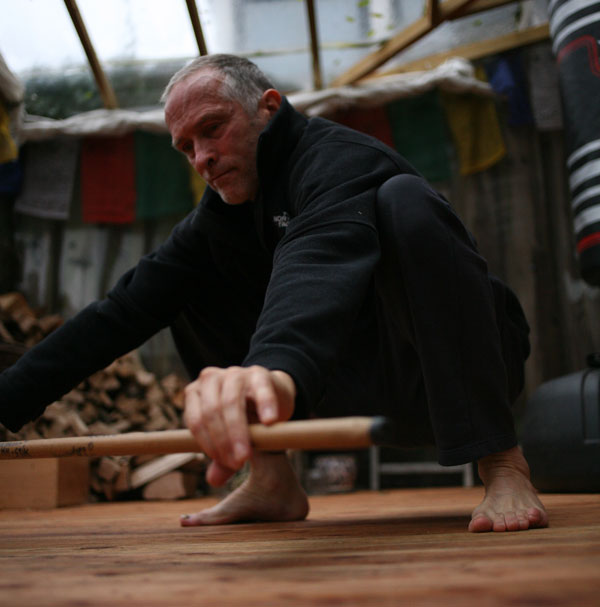 Hans Spaans has suffered from Parkinson’s Disease for twelve years and claims that the Wim Hof method has allowed him to drastically reduce his dependence on pharmaceuticals. He sits here in a squat before his morning calisthenics routine. (Photo by Scott Carney)
Hans Spaans has suffered from Parkinson’s Disease for twelve years and claims that the Wim Hof method has allowed him to drastically reduce his dependence on pharmaceuticals. He sits here in a squat before his morning calisthenics routine. (Photo by Scott Carney)
Dragon Door: Other than your background in anthropology, how did you get into investigative journalism, especially debunking gurus and others making wild claims?
Scott Carney: I was a graduate student working toward my PhD until about 2005, but dropped out right before the dissertation. The last thing I did as a graduate student was lead an abroad program for American college students throughout North India. We went to various religious sites—I think the program was called "From Brahma to Buddha"—to learn about various Indic traditions. In Bodh Gaya, where Buddha attained enlightenment 2,800 years ago, we did a ten-day silent meditation retreat in the Tibetan tradition. At the retreat, we were meditating on death, but also very positive things like enlightenment, nirvana, bliss, and understanding our true natures. On the last day of the retreat, one of my most put-together students, Emily O'Conner (that's a pseudonym, but it's what I've been calling her for the past three books) climbed up to the roof of the retreat center, wrapped a shawl around her head and jumped to her death. She committed suicide—and here I am, the 27-year-old the director of the program. I had to bring her body back to the United States to her family, and I was also part of the police investigation. There was a murder investigation, and it was a really horrible thing.
The last words she wrote in her journal were "I am a Bodhisattva". Basically, she was saying that she was enlightened and all she needed to do was to leave her body to be reborn into something like a god. I thought it was crazy and horrible. I wanted to understand how something so blissful could end so tragically. At the same time I saw a very lively, wonderful, beautiful person essentially become meat—and then people fought over her body parts. Her family wanted her intact body, the insurance company wanted the body, the police wanted her liver and her brain...it was a nightmare.
I began to think about what happens when a body becomes meat, which lead me down an investigative path. My first book, The Red Market, examines organ trafficking around the world. At that point, I was writing for Wired, Mother Jones and NPR and uncovered all these black markets for human tissue—kidneys, skeletons, hair, surrogate wombs, pregnancies, IVF. Once the body is thought of as an inert object, then horrible, horrible crimes occur. The Red Market was the first book in the series.
In the second book, I went back to Emily’s death and asked why she killed herself. Beyond the meat of her, I wanted to learn about her experience. I started to look at madness and meditation. I collected the journals of people who committed suicide on meditation retreats or ended up in mental institutions and I found an epidemic. Many people, especially Westerners, have mistaken ideas about spiritual paths, and they mix and match religions. A lot of what is taught in America as Buddhism, yoga, or Eastern philosophy is actually a mixture of Christianity, Buddhism, and essentially shamanic and witchcraft religions in Asia. So, it’s no wonder that people who are deluged with this hodge podge end up going crazy.
My third book, What Doesn't Kill Us is where I am trying to understand how we can talk about the benefits of spirituality. It’s the positive side of the previous two books where I want to understand what the capabilities of the human body when we combine the body and the spirit in a responsible way. Wim ended up being my vehicle to explore those ideas. I believe the body, mind, and soul are all one thing, and when those parts work in concert, we're able to accomplish amazing things.
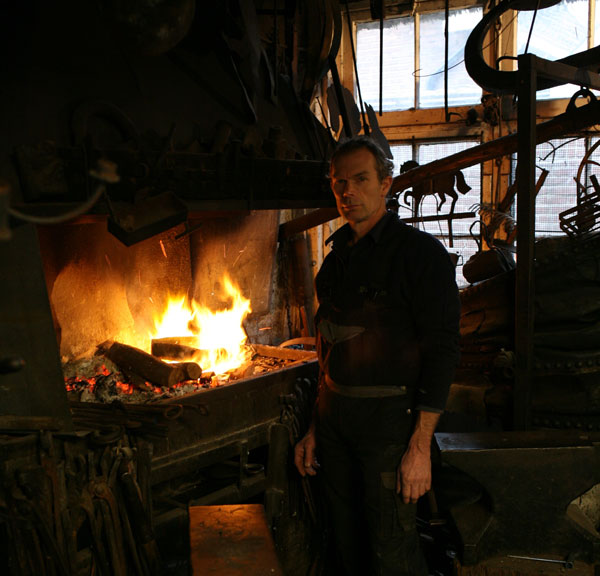 Henk van den Bergh suffered from crippling rheumatoid arthritis that had left him immobile at home. His condition has drastically improved since adopting daily ice baths and a rigorous breathing routine. (Photo by Scott Carney)
Henk van den Bergh suffered from crippling rheumatoid arthritis that had left him immobile at home. His condition has drastically improved since adopting daily ice baths and a rigorous breathing routine. (Photo by Scott Carney)
Dragon Door: I enjoyed watching the mental shift happen in your book. It sounds you went though some pretty big lifestyle changes while writing What Doesn’t Kill Us. When you were practicing and studying and meditating and jumping in the cold water with Wim, when did you transition from skepticism to noticing how the training was working for you?
Scott Carney: It was sudden. The first time I did the push up practice—I went from being able to do twenty pushups normally to doing forty of them in a matter of fifteen minutes. It changed my relationship with my body. I am a very open-minded person, I'm willing to be contradicted and challenged. When I find something that works, I want to know more.
I’m still skeptical of some of the claims around the Wim Hof Method. Some outrageous claims are continually put forward and people sometimes do very dangerous things and make dangerous decisions because they believe in Wim the guru. I find that very disheartening because the beauty of Wim is that he is not superhuman, and he's not the perfect individual. If you know him, he is sort of a crazy guy who smells bad who makes terrible decisions in his life over and over again. He's possibly an alcoholic and was a smoker for many years. He's had children with a few different women and he has enough negative qualities that you would never want to be him. Wim is the worst role model! But, knowing that and knowing all his flaws—Wim and I talk about this all the time—actually allows me to accept the good. I will never put Wim on a pedestal and I don't think anyone should. People are doing that now, and it's a problem. But once I got to know Wim, his flaws were so obvious that it let me focus on the good and throw out all the bullshit around him. I was easier for me to trust him because I can remain skeptical and still see the magic.
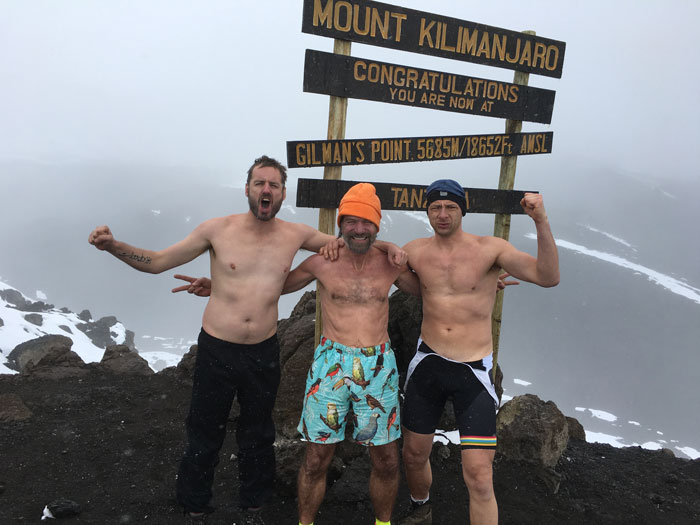
Scott Carney, Wim Hof, and Dennis Bernaerts at Gilman's Point on Mt. Kilimanjaro.
(photo by: Salim Hamis Ngonye / Scott Carney)
Wim is all over the map, but his great abilities and inspirational message are within his follies. I hope that that comes out in the book. And you'll see in the end I'm hiking up Mt. Kilimanjaro with Wim. On the hike, he made some terrible decisions that could have gotten people killed. I think of him as a madman and a prophet—but the way he climbed that mountain basically alienated everyone in the group and pushed us to a place where even the guides were saying to stop before someone died. Yet, I went up the mountain with him anyway—which was partially because I was there to write about it. I also realized that this was my journey, and I was doing it on my own terms and about the process of studying these techniques for four years. So, while I have a convoluted relationship with Wim, overall I am glad he is in the world. He is the messenger of this amazing thing, and no one but Wim could have discovered it.
Dragon Door: And the guts to try it out!
Scott Carney: And the intuition!
Dragon Door: Usually when we think of health, fitness and exercise it’s all about general health, body composition, strength, conditioning by way of diet and exercise. Wim's training includes a focus on a third element, exposure to extreme environmental variations. It seems to be the third pillar stimulating brown fat and strengthening the muscles around blood vessels. How was your experience with adding that third element to your lifestyle?
Scott Carney: Our species is 200,000 years old and we’ve lived with constant variation in the environment. Our bodies are honed for that natural variation in them and are actually part of the environment. I don’t see the body as bounded by skin anymore, I see it in constant communication, and the end of that communication is the true boundary of the body. We’re essentially a reflection of the environment we inhabit. Living in a static 72-degree indoor environment, all year round, summer and winter, day and night, under-stimulates our biology.
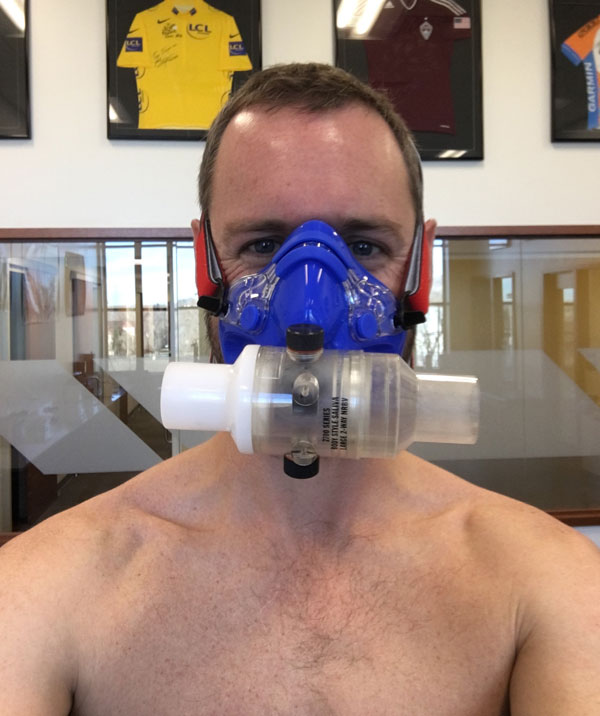
Scott Carney tests his carbohydrate and fat burning capabilities at the CU Sports Medicine and Performance Center. (Photo by Scott Carney)
As I write in
What Doesn’t Kill Us, environmental variation really is a third pillar that is very rarely recognized. In my own training, I don't do many other exercises. My wife is a very dedicated gym person, but I am not. I mostly do metabolic work and it does great things for me. Then, through modulating the environment, I have been able to vastly change my ability to metabolize fat. Now, I can endure variations in temperature very well and am better able to accomplish challenges when I undertake them. I was able to hike up Mount Kilimanjaro, and I did the Toughguy Race in England while just wearing a bathing suit. Most of that ability came from Wim's breathing method and the environmental conditioning. I use a modified version of his breathing method that only takes about 15 minutes, but it's very much inspired by what I learned from
Wim Hof. I take cold plunges and cold showers when I can.
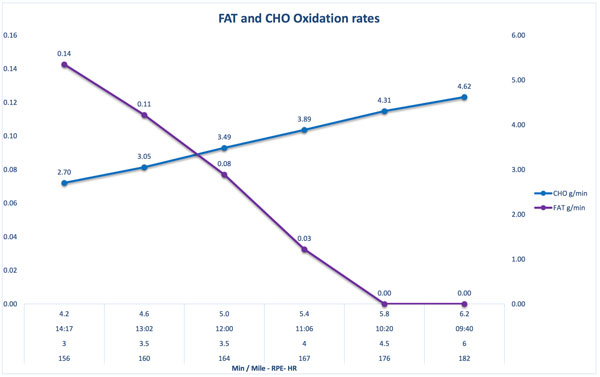 Scott’s baseline carbohydrate (blue) and fat (purple) burning profile as he reached his VO2 max recorded on May 1, 2015 before starting the Wim Hof method on a regular basis. He managed six stages and the two lines intersected between the 2nd and 3rd stage (meaning he started burning more carbs and fewer fats at that point.)
Scott’s baseline carbohydrate (blue) and fat (purple) burning profile as he reached his VO2 max recorded on May 1, 2015 before starting the Wim Hof method on a regular basis. He managed six stages and the two lines intersected between the 2nd and 3rd stage (meaning he started burning more carbs and fewer fats at that point.)
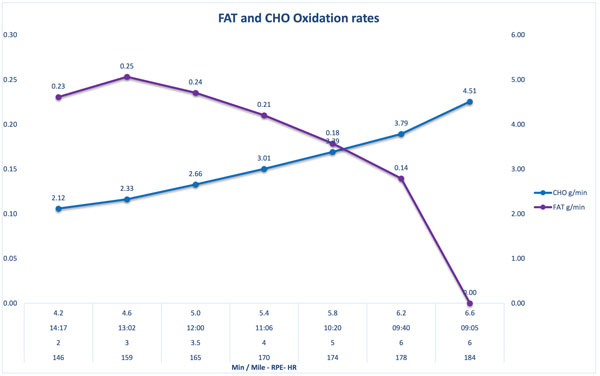 After several months of practicing the Wim Hof method, but otherwise keeping his exercise routines the same, Scott managed to radically change his metabolism. This graph of his results from the January 27, 2016 test indicates he managed 7 stages of increased exertion and, more importantly, continued to burn primarily fat for five stages of the test. To quote Rob Pickles, "Big picture: you’re a lot more efficient with how you use energy than you were when I tested you in the summer. It’s like you’d added seven hours of exercise to your routine every week."
After several months of practicing the Wim Hof method, but otherwise keeping his exercise routines the same, Scott managed to radically change his metabolism. This graph of his results from the January 27, 2016 test indicates he managed 7 stages of increased exertion and, more importantly, continued to burn primarily fat for five stages of the test. To quote Rob Pickles, "Big picture: you’re a lot more efficient with how you use energy than you were when I tested you in the summer. It’s like you’d added seven hours of exercise to your routine every week."
Dragon Door: What do you think are the implications for the obesity epidemic with that third pillar?
Scott Carney: I think it could absolutely help obesity since it is a condition where too much energy is in the system and our bodies are designed to store excess energy mostly as white fat. One of the problems with exercise is that the body would rather burn muscle and carbohydrates than white fat because white fat isn't there for caloric muscle energy, it’s a reservoir of heat energy in solid form. Our bodies metabolize it to release heat through either brown fat or other metabolic processes—depending on a person's underlying physiology.
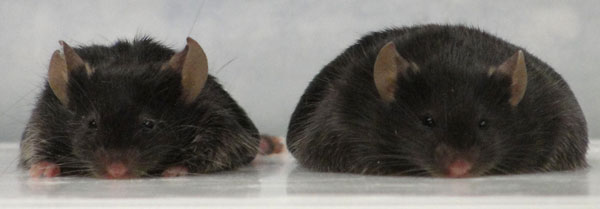 These two identical mice were kept in a cold room for several days. The mouse on the left was given a drug named GC-1 which stimulated brown fat product and activation. The mouse on the right is the control group. The results indicate that brown fat can be a key driver in weight loss. (Photo by Kevin Phillips)
These two identical mice were kept in a cold room for several days. The mouse on the left was given a drug named GC-1 which stimulated brown fat product and activation. The mouse on the right is the control group. The results indicate that brown fat can be a key driver in weight loss. (Photo by Kevin Phillips)
As for the obesity epidemic, the cold can certainly help. But if someone is very obese, their body may not choose to increase their metabolism—instead it may rely on the insulating properties of white fat instead. The people who benefit the most from the metabolic increase with brown fat are those who are either slightly overweight are wanting to maintain their weight within a normal range. It may work for someone 30-40 pounds overweight, but not for someone who is morbidly obese. I think a lot of medical research focused on the properties of brown fat for diabetes and obesity misses the point. The brown fat doesn’t matter as much as the cold. The environmental condition triggers the physiological response. We should be focusing on that response, not the specifics of the neurotransmitters or the hormonal releases. In one of the studies I cite in the book, a researcher in Holland had a group of diabetic men dressed only in shorts stay in a 52-55°F cold room for three hours a day for three weeks. He tested their brown fat and insulin production over that time. He found that their diabetes improved by about 52-54% after cold exposure because their insulin resistance decreased. Their diabetes was in the process of reversing itself just because of the cold. He had assumed the properties of brown fat would improve their metabolism, but when he measured their brown adipose tissue (BAT) it actually stayed exactly the same. He was confounded because while he had predicted their insulin resistance would improve, it happened by a mechanism than BAT. After further research, he discovered that their muscles had improved how they handled energy, they now had additional mitochondria in their muscle tissues. This is why we shouldn’t necessarily focus on the small mechanisms of the body when we're missing the whole picture.
Dragon Door: One of the hardest things to believe is Wim's ability to train his immune system—and that he has been able to teach others to do the same. What was your experience when learning that process? Do you feel like you can control your immune system a little more now?
Scott Carney: I don't know that I can control it, I can't tell it to go attack a pathogen, but I feel like I can give my immune system a sort of boost. I think it’s attributable to the cold showers and the breathing method. The only real evidence I have is that I'm a pretty healthy guy in general, but have been afflicted with canker sores my whole life. They’re big, nasty mouth ulcers and they used to get particularly bad—the size of a dime—which made it impossible to smile or talk. It was a miserable experience and I used to get them about once a month. Since doing the cold training and breathing exercises, I only get them maybe once a year—and when I do, they're very small and go away faster—it’s a relief.
Obviously, there are also the studies with Wim consciously resisting the stimulus of endotoxin in a laboratory setting. A year later, there was a test on a group who had trained with his methods which showed they were able to do it as well. The science behind the method is very promising. But, it's by no means complete or conclusive at this point.
Dragon Door: In your book, it sounded like you've added Wim Hof Method training into your daily lifestyle. Are you still doing your 15-minute practice?
Scott Carney: Almost every day!
Dragon Door: And even though you've climbed Mt. Kilimanjaro, do you have any new feats or goals on the horizon?
Scott Carney: Not in particular, other than I have some other book ideas in mind. I am going to continue with the training because I think it’s beneficial for me. But as for feats, I don't know if they're necessarily important. This is really about a personal journey and even small things can be big things. Sometimes even just sitting in cold water is just about the feeling that it produces, rather than staying in there longer than someone else. In many ways, another big attraction of the Wim Hof Method community is the machismo of "I can do this and you can't" or "I can stay in the ice water longer than you". Some of the meetings get silly when it’s a lot of guys "manning up". That shouldn't be what it's about. It should be about working on your own biology. Being able to do more pushups or stay in the ice water longer than someone else doesn’t mean that you're a better person.
There’s also the risk that when people get competitive, they will push themselves too far. That's why there's been deaths in the Wim Hof Method, when people do stupid things to try and beat nature. Luckily, there are more women involved now which seems to helps the situation. I think there should also be all-women Wim Hof Method groups so they can get their own things out of it. But in general practicing the method should be non-competitive—it’s about how I interact with my own immune system, not how I interact with someone else’s.
Dragon Door: One last question. Since you went to school for anthropology, has that helped you put these practices and approaches into a particular context of a modern culture?
Scott Carney: I think that Wim is as much of a product of the modern world as any of us. But, I think Wim has found a backdoor into some of the abilities of our indigenous ancestors. The other very good thing about the Wim Hof Method is that it's very quick. If you look at Tummo, the Tibetan tradition of meditating in snow, it takes ten years to learn. If you really want to learn it, you have to go through Long Rim first. Tummo is kind of a secret teaching, it goes through the mind so the specifics of mental visualizations invoke deities and Tibetan and Sanskrit letters. It’s symbolic and also has a breathing method, but it first comes thought the mind then the body before you generate heat. So, while the Tibetan monks may be able to do it better than Wim, Wim is able to get someone the same basic results in a week. In the modern world, we like this type of rapid result, and it works because Wim first goes through the body and uses the body to impact the mind. So, you don't get into the same trancelike state as in Tummo, but you will force the mind into submission because you are stimulating it from the outside.
Back